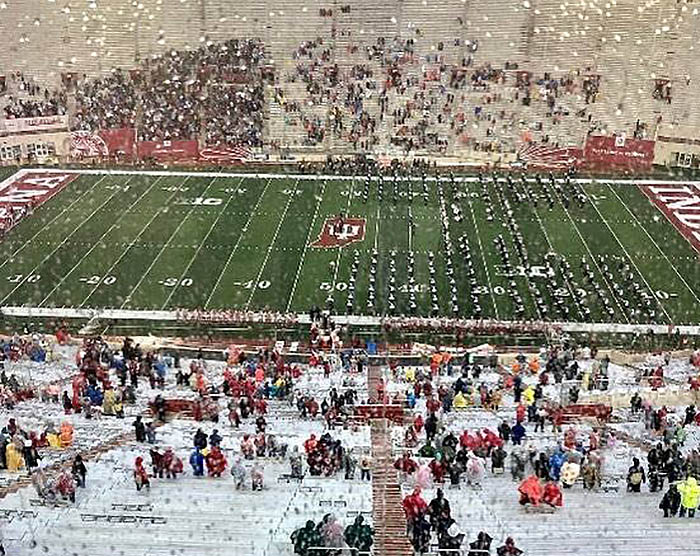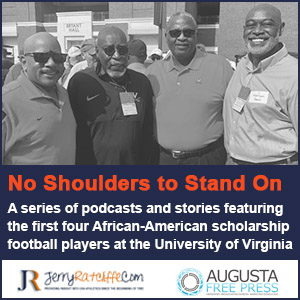Bronco Encouraged By His Team’s Strong Second Half Effort

Bronco Mendenhall had a strong message for his football team on Saturday night before the Cavaliers departed rain-soaked Bloomington, in a 20-16 loss to Indiana.
“My message to them was that I really liked how they finished the game in terms of the mindset of the second half,” the Virginia football coach said. “That in and of itself gave us a great chance right to the end.”
UVa, now 1-1 with Ohio University (1-0) coming to town, trailed Indiana 20-9 at halftime in a driving rainstorm. The Cavaliers showed a lot of moxy by coming out and putting together a strong second half effort.
Linebacker Charles Snowden blocked IU’s 41-yard field goal attempt to open the second half, and UVa quarterback Bryce Perkins led the Cavaliers on a 65-yard scoring march on his team’s first possession of the half and put them within striking distance. Virginia’s defense shut out the Hoosiers in the second half, leaving things up for grabs at the end when a desperation Hail Mary toss was unsuccessful on the last play of the game.
“That’s where our program is in my opinion,” Mendenhall said. “We’re battling for these kind of games. A year ago we’re on the field and have to make stops on fourth down to win games, and this time we’re throwing it in the end zone to try to win a game. So when you’re in that stage, every single drive matters.”
With all the things that went wrong – UVa’s defense gave up more than 200 yards to IU’s freshman running back; at least two big calls by the Big 10 officiating crews went against the Cavaliers; and normally sure-handed kickoff return man Joe Reed fumbled, giving the Hoosiers and easy touchdown – Mendenhall couldn’t fault his team’s overall effort, particularly in the second half.
“I think it was a tale of two halves,” the coach said. “We were tentative in half one, and more aggressive in the second. There’s plenty to build on.”
Even though IU’s physical true freshman running back Stevie Scott rushed for 204 yards on 31 carries, UVa’s defense only bent in the second half and didn’t break.
“The stops, and let’s face it, 20 points gives you a great chance to win the game,” Mendenhall said. “Regardless of the other statistics, 20 points and you’ll always be in the game.”
Scott became the first back to rush for 200 yards against Virginia since Oregon’s Royce Freeman gained 207 (21 attempts) in the second game of the 2016 season in a 44-26 Cavaliers loss in Eugene.
While the Hoosiers didn’t score the second half, the fact that Scott kept the chains moving allowed IU to control the pace and field position for the most part, and kept the ball out of Perkins’ hands.
When Virginia got the ball back for the last time at its own 9-yard line with 3:23 to play and only one time out remaining, it was a testament of how Perkins, a junior college transfer from Arizona Western, can perform under pressure.
Much of Indiana’s defensive preparation centered around stopping or at least limiting Perkins, a mobile quarterback. Hoosiers coach Tom Allen revealed after the game that he essentially put a “spy” on Perkins for the game, linebacker Reakwon Jones.
“We had several calls where we spied him on the quarterback and [Jones] came up big,” Allen said.
Still, Perkins, who took a couple of hits in the game, came up big in the end and nearly stole the show under adverse conditions. He led Virginia on a 16-play drive from his own 9 to the Indiana 27, converting one third-and-seven on an 8-yard pass to wide receiver Hasise Dubois, and a fourth-and-four pass to running back Jordan Ellis to keep the drive alive.
He rushed for 25 yards and completed 4 of 9 passes for 35 more yards on the drive, not including the pass interference call on the Hoosiers that remained controversial in nature.
Still, Perkins had a chance on the last play, tossing the ball 27 yards into the end zone where a crowd of receivers and defenders fought for the ball that fell incomplete.
“Basically, for a lack of a better term [the play] is called Big Ben,” Mendenhall said. “So, there are three players that will go up for the ball and a trailer that will slide behind in case it’s tipped or knocked forwards. It was a nice throw, there was a bunch of hands that went up and sometimes you come down with it and sometimes you don’t. Bryce gave us a chance.”
That’s one of the things Mendenhall took from the game, that Perkins is most always going to give the Cavaliers a chance in a close game.
“I think Bryce showed a lot of courage and fortitude and gamesmanship,” Mendenhall said. “He gave us a great chance.”
Perkins, in only his second major college start, completed 12 of 24 passes for 106 yards and a touchdown, no interceptions, no sacks. He also rushed 25 times for 123 yards (4.9 per attempt), including a 47-yard run.
Perkins became the first Virginia quarterback to rush for 100-plus yards multiple times in the same season since Bill Dudley in 1941, and I’m not sure that Dudley was technically a quarterback even though they would direct snap to him to throw the ball because he had a better arm.
That’s staggering folks.
“It was a little bit of a learning curve with Bryce,” Mendenhall said. “His fighting spirit and battling in that last drive, there was a lot of good things he did there.”
Virginia’s game plan, influenced by the severe weather conditions and a wet football, was somewhat conservative in the first half as Mendenhall and his offensive staff were trying to get a feel for what they could and couldn’t do due to the driving rainstorm and 13 mph winds.
In addition, it was the first time Perkins had ever played in rain, even though UVa does practice in the rain when it gets the opportunity.
“Yeah it was harsh conditions,” Perkins said. “I had never really thrown in the rain before so Coach was trying to be smart and call smart plays, move the ball forward any way we could.
“I thought we did a pretty good job [on the last drive] of moving the ball down the field,” Perkins said. “A couple of things didn’t go our way.”
One of those things was a pass interference call on Indiana corner Raheem Layne, who knocked Dubois down on a fourth-and-five situation from the Virginia 31 as the clock ticked down from 16 seconds to zero on the play.
Officials gave Virginia a first down at the 27, a four-yard penalty, and put no time back on the clock, but rather said there would be “one untimed down.”
“I have no idea what happened there,” Perkins said. “I just knew we got the ball back and had another chance to win. And I put the ball in the end zone. I wasn’t concerned of how they called it or why they call it. Just that we had the ball back.”
Mendenhall said he was told it was a “spot foul.”
“I saw it clearly,” the coach said. “The ball was in the air and [Layne] pushed our guy down, that was before he intercepted it and took off. That’s what I was told.”
One huge play in the game was Reed’s fumbled kickoff return, forced by IU’s Micah McFadden and recovered by Bryant Fitzgerald at the Virginia 21 with 6:16 to go in the first quarter. Two plays later and the Hoosiers were celebrating in the end zone.
The only thing that made it less difficult was that UVa’s Juan Thornhill blocked the PAT and returned it for a two-point Cavaliers score. Indiana led 13-9 at that point.
“Man, when you consider a game that goes down to the very last play, every possession counts,” Mendenhall said. “As much as that one hurt us, the two blocked kicks really helped. But yea, that did hurt because [IU] capitalized on it.
Mendenhall was actually surprised that Indiana kicked the ball to Reed, who is a speedy return man that has taken two kicks back for touchdowns (last season).
“I guess we perceive [Reed] as a bigger threat than they did,” Mendenhall said. “We were excited when he caught it and thought that would be a positive thing for us. We would love the opponents to kick it to Joe. We’ve encouraged him to catch it and run with it and the confidence built is regardless of conditions. Unfortunately he didn’t hold onto it today.








